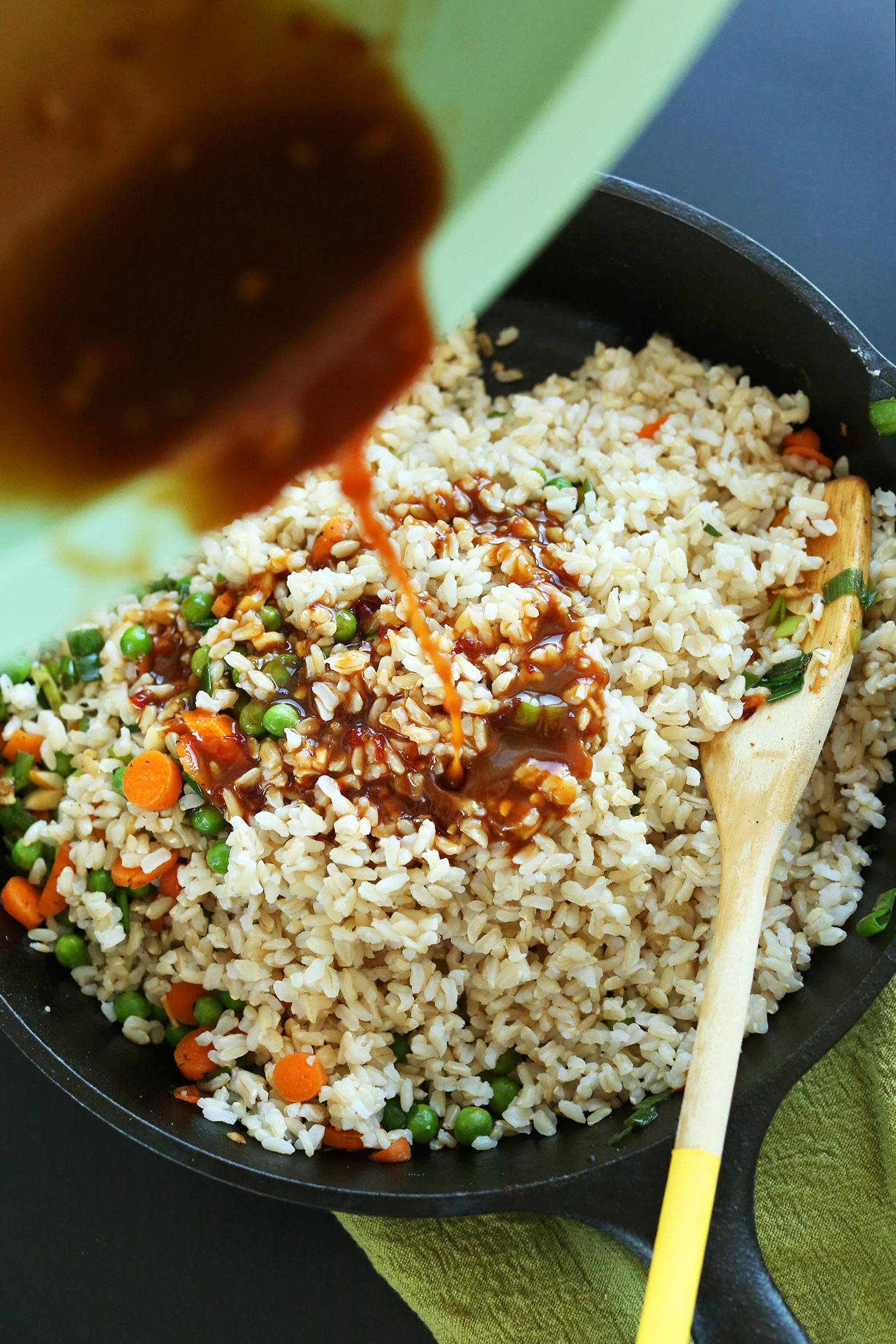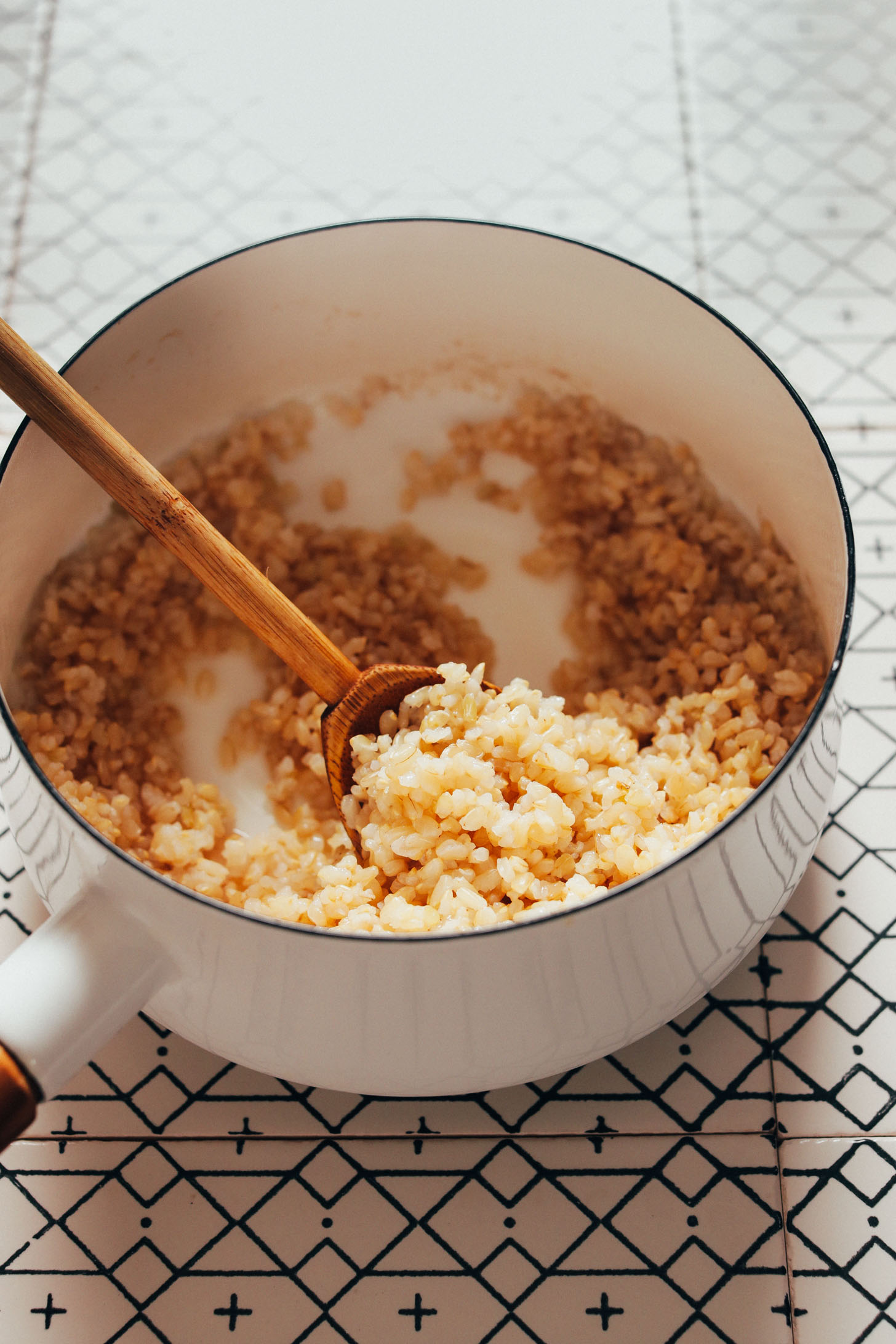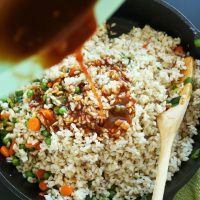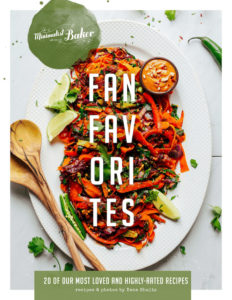
If you’ve ever cooked brown rice that turned out gummy, undercooked, or stuck to the bottom of the pan, join the club. I’ve been there.
BUT, since my earlier failed attempts, I’ve discovered 2 foolproof ways to cook brown rice that produce perfectly fluffy, tender rice every time. Let me show you how it’s done.
Do you have to soak brown rice before cooking?
Soaking is optional, but we recommend it! Soaking grains helps to remove some of the naturally-occurring phytic acid in the grain, which helps improve digestibility and speed cook time.
To soak: Add rice to a large mixing bowl or pot and cover with twice the amount of lukewarm water (1 cup rice + 2-3 cups water). Soak uncovered at room temperature for at least 2 hours or overnight. Then drain and rinse once more.
How to Cook Brown Rice
There are many ways to cook brown rice, but we have narrowed it down to our two favorites.
Method 1 makes extra fluffy, tender rice, while Method 2 is faster (since the smaller amount of water boils more quickly) and still yields a fluffy result!
Option 1- The “Pasta” Method
This method is very similar to cooking pasta in that you fill a large pot with water, bring to a boil, add rice, cook, and drain. After draining, the rice is added back to the pot (off the heat) where it steams for 10 more minutes.
How much water to cook brown rice with method 1?
- ~12 cups water (yes, twelve!)
How long to cook brown rice with method 1?
- For soaked rice: 20 minutes + 10 minutes off heat
- For unsoaked rice: 30 minutes + 10 minutes off heat
Option 2- The “Quick & Simple” Method
The second method requires less time and is still delicious! The water and rice are added to the pan, then brought to a boil, reduced to a simmer, and cooked with the lid on. Once the water is absorbed, remove from the heat, uncover, and allow to sit for 10 more minutes.
How much water to cook brown rice with method 2?
- For soaked rice: 1 cup rice to 1 ½ cups water
- For unsoaked rice: 1 cup rice to 2 cups water
How long to cook brown rice with method 2?
- For soaked rice: 15 minutes + 10 minutes off heat
- For unsoaked rice: 25 minutes + 10 minutes off heat

Recipes Using Brown Rice
- Easy Vegan Fried Rice
- Sweet Potato Black Bean Burger
- Brown Rice Sushi
- Crispy Miso Chickpea Bowls
- Gado Gado with Spicy Peanut Sauce (30 Minutes!)
- Spicy Red Lentil Curry
- Vegan Stuffed Poblano Peppers
If you try this recipe, let us know! Leave a comment, rate it, and don’t forget to tag a photo #minimalistbaker on Instagram. Cheers, friends!
How to Make Brown Rice (2 Ways)
Instructions
- Optional: Soaking grains helps to remove some of the naturally-occurring phytic acid in the grain, which helps improve digestibility and speed cook time. To soak: Add rice to a large mixing bowl or pot and cover with twice the amount of lukewarm water (1 cup rice + 2-3 cups water). Soak uncovered at room temperature for at least 2 hours or overnight. Then drain and rinse once more.
Method 1
- For extra fluffy rice, start by bringing 12 cups of water to a boil in a large pot. Once boiling, add rinsed rice and stir. Boil on high uncovered for 20 minutes (if soaked) and 30 minutes (if not soaked) or until tender (sample a grain of rice to test doneness).
- Then strain for 10 seconds and return to pot removed from the heat. Cover with a lid and let steam for 10 minutes. Then serve! This rice is delicious in things like stir fries, sushi, fried rice, with stews, and more!
- Store cooled leftovers covered in the refrigerator up to 5-6 days, or in the freezer up to 1 month. Reheat in the microwave or on the stovetop with a little oil or water until warm.
Method 2
- Add water and rice to a medium saucepan. If you soaked your grains, you’ll add 1.5 times as much water as rice, which in this case would be 1.5 cups. If not soaked, you’ll add 2 cups water. Bring to a boil and once boiling, lower heat to a simmer and cover.
- Cook until water is completely absorbed and rice is tender – about 15-25 minutes (will depend on whether or not the rice was soaked). Drain off any excess water if there is any. I like to turn off the heat and remove the lid for 10 minutes so the rice gets fluffier. Feel free to fluff with a fork at this time as well. Then return the lid to keep warm until serving. This rice is delicious in things like stir fries, sushi, fried rice, with stews, and more!
- Store cooled leftovers covered in the refrigerator up to 5-6 days, or in the freezer up to 1 month. Reheat in the microwave or on the stovetop with a little oil or water until warm.
Video
Notes
*Method 1 is from Saveur!
*Nutrition information is a rough estimate without salt added to water.


Wanda G says
I’ve been searching for a method for “prepping” brown rice for recipes that call for white rice. This seems like it will help me to adhere so many beloved recipes I’ve saved to use brown rice instead. Thank you so much!
Patti says
The soaking method overnight was wonderful! I can eat and comfortably digest brown rice now! Thank you.
Yay! We’re so glad that method has been helpful, Patti. Thank you for sharing! xo
V says
I highly recommend Method 1, if you don’t have a water shortage, as it removes more arsenic from the rice (look this up, there is now an issue with arsenic in the water table in many countries).
Marie Groizard says
Thank you for the very easy recipe, I will give it a go and let you know how I go.
Great! Excited to hear what you think!
Charity says
For method 1, why do you leave the rice uncovered? What difference does it make? Can you leave the lid on so that I can use less water?
Hi Charity, we would recommend covering it (see instruction 2). Leaving the lid on still requires the same amount of water if using the pasta method for extra fluffy rice. If you’d prefer to use less water, see method 2. Hope that clarifies!
Anonymous says
I cook 1 1/2 cups/300g wholegrain basmati rice with 1.5L water (6 1/4 cups) and sieve off leftover water at the end (a few tablespoons). I still get fluffy rice and it suits my morals (we will all be suffering with droughts soon so less water options, while keeping food standards high is a necessity!!)
Trevor H. says
Brown rice is my go-to rice as I’m diabetic. Frankly, white rice’s 🍚 high *glycemic index literally puts me to sleep! If my brown rice is at all wet, I microwave it for a minute or two to dry it off. Sorry to see to mention microwave ovens, knowing chefs eschew all methods except traditional pots and pans, but they’re great for rice and don’t burn it either. Sß 🐷
*glycaemic index… article of that name (Wikipedia) explains.
DONNA says
Yes, Finally GOOD brown rice at home. THANK YOU SO MUCH!!!!! I used method 1 for 2 cups of rice soaking for 2hours cooked 20 min., steamed 10min. PERFECT RICE.
Yay! Thanks, Donna!
Mst Ruma says
Wow this is a very helpful post for me. I followed method 1 it was very easy and perfect.
Yay! We love to hear this. Thank you for the review!
Laura Thomas says
My Japanese friend uses the soaking water on her plants. I’ve started doing that with all my soaking, boiling and steaming water…from artichokes to grains.
wow love that idea!
Laura Thomas says
She has fabulous orchids! Potato water good too!
Laura Thomas says
Why no mention of salt?
Hi Laura, no specific reason. Feel free to add it!
Alex says
Hi, just a quick question. When straining the rice, if I decide to use water to help remove excess starch how do I then go about steaming it? As I worry that the rice will be cold after using water to remove the starch. Would it be beneficial to leave the pan over a low heat before returning the rice to it?
Hi Alex, you could try rinsing with warm water, perhaps? But we don’t find rinsing necessary with this method and would recommend giving it a try as written!
Kimi says
Staying true to the site’s name? ….minimalist 😘
Judith Vera-Barra says
I only changed my method of cooking brown rice because of the arsenic levels that most rice in this country (US) has. (https://nutritionfacts.org/2020/12/15/which-rice-has-less-arsenic-black-brown-red-white-or-wild/)
I now use the “pasta” method, since that gets rid of approximately 60% of the arsenic found in brown rice. I think I will use the other method I used to use only when I’m making something special like paella. I cook white rice once in a while for a treat (love it! more than brown, even).
Siara says
Wonderful technique and reference! I utilized both ways and find them fun, actually! This time, in prep for the pasta method, I actually lightly browned the soaked rice in Irish butter then added seeds, garlic, onion powder, and extra pepper 🤤 then added hot water to boil! Thank you for all that you do!
Love the modifications, Siara! Thanks so much for the lovely review!
George says
Was the perfect rice in my life thank you so much
Yay! Thanks for sharing, George!
April Guscott says
Can I soak minute rice and , would it work the same way following either of your methods, but just cook faster I guess?
Hmm, we’re not sure. Let us know if you try it!
Katy Ionis says
Why am I just now trying this method of cooking brown rice like pasta? It’s a revelation! I soaked short grain brown rice overnight and used method 1 and it’s the best brown rice I’ve ever made – each grain is separate, there is no sticky starchy gunk as I’ve always had no matter how much I rinsed the rice, and it’s more forgiving than watching to turning off at just the right time when all the water is absorbed and rice is cooked with method 2. Most people will skip this recipe because they’ve been making brown rice for years and know how to, but wow I wish I read this years ago.
Is there any nutrition drawback to method 1 with dumping out the water? Do you do this method with white rice as well?
Thank you!!
We are so glad you enjoyed it, Katy! We’re not aware of any nutrition drawbacks, but we can see why you might ask that. We haven’t tried it with white rice as we find this method yields fluffy rice without an issue.
Tina says
Would it be the same for white rice?
Here’s our recipe for cooking white rice: https://minimalistbaker.com/how-to-cook-white-rice/
Ramaiah says
After cooking the brown rice, do we need to remove the starch.
We don’t find it necessary!
Phaedra says
i used the second method but found that my rice was not done at the 20 min mark. I had soaked it previously for 12 hours+ and used the recommended water to rice ratio. I think the problem was that my pot was too wide. I was only cooking one cup of rice and it spread out too thin on the base of the pot, so maybe there was not enough “height” for the rice to cook in. I added water 3 times and still after 40 minutes the rice was only half cooked. I ate it anyway of course!! lol
So strange! Was you rice fresh and what kind of cooktop do you have (gas or electric)?
Richard Coleman says
Method 1 has become important for several reasons. America’s Test Kitchen in their book “The Complete Vegetarian Cookbook” recommend it as an option particularly for brown rice since many people had trouble using the recommendation on the rice package. However, now as the issue of arsenic in rice has risen to the surface the recommendation is to soak the rice and use Method 1 since the arsenic is washed out in the large volume of water. You have to periodically test how done the rice is for the timing. A simple search using arsenic and rice as key words will describe the problem. I have always steamed my rice without soaking, but I use a pressure cooker with the pot in pot method and it was very efficient. Now I am switching to Method 1. I use Lundberg organic sprouted short grain brown rice. Lundberg now tests for arsenic, and it doesn’t matter whether you use organic and/or sprouted rice, there will still be arsenic in the rice. I asked Lundberg about this. Method 1 is good and easy, but of course you use much more water.
Priya Benny says
Hey,
In the first method it says to add 12 cups of water to one cup of rice to get fluffy rice
Yep!
Mash says
I’m a little lost here too… 12 cups water, 1 cup rice?
Hi Mash, those measurements are correct. This method is similar to cooking pasta. The excess water is drained out.
John says
That’s for pre cooking
Mia says
Hi Dana! Thanks for the wonderful how-to posts you’ve been adding to the website. If I were to use long-grain brown rice, would the cooking times change for either method? Thank you!
Hi Mia, good question! It should be a similar cook time.
Avia says
I used method 1 and it was awesome, I overcooked a little in the boiling stage but the steaming seemed to rescue it, amazing! I had it with the 20 min tofu stir fry ?
Thanks for sharing, Avia!
Jan says
I used your recipe and the rice is perfect
Thanks for sharing
Rikki says
I haven’t tried these ways, but I actually bake my brown rice now! 1 and 1/2 cups brown rice to 2 and 1/2 cups water in a 9×9 pan. Cover tightly with a double layer of foil. Bake at 350 for an hour. Perfect rice every time! And no stress or babysitting a pot!
Thanks for sharing, Rikki!
Kaylen says
Is this for soaked rice?
Rose says
Hi,
Im just starting to use Brown Rice, I yried it many years ago but didnt like the texture (obviously I cooked iy wrong). The Oven meyhod sounds awrsome, no fuss, no worry, so has anyone made Fried Rice with this? Thanks in advance!❤
Lisa says
For your oven method…are you using short or long grain and do you pre-soak the rice or no?
Short grain usually! But long grain should work, too. I’d say soak both.
Pickle Relish says
I made it the #1 way, it was delicious but next I want to either soak the rice over night if I remember or at least the 2 hours and boil it. My old way of cooking rice made making rice in this house almost never but now I learned a better way and brown rice will be enjoyed more. Thank you for this video.
Holly says
Best rice I’ve ever made! I used method 1 and it’s so fluffy. I filled my 8-quart stock pot about halfway with water and cooked 400 grams (about 2 cups) of rice. Such a perfect, simple recipe!
Anne says
Method 1 is the only way to make fluffy brown rice without a rice cooker ! So simple and easy – I just set the timer on my iPhone while I do other preparation.
Awesome! Thanks for sharing, Anne!